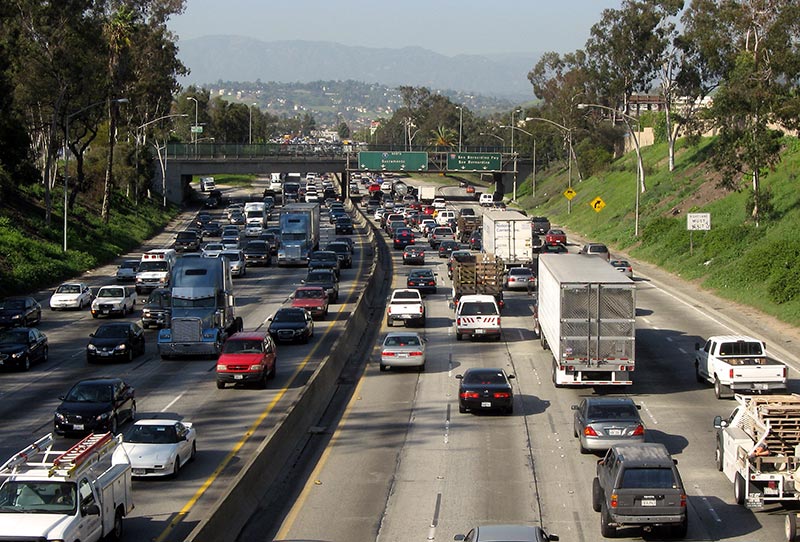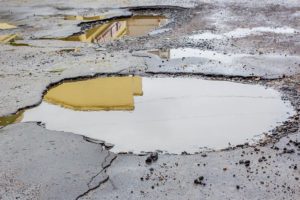
I-5 is not the longest freeway in the country, but it is the busiest. The Department of Transportation’s Federal Highway Administration released a report in 2011, which found that I-5 was the most-traveled interstate in the country, with drivers putting more than 21 billion miles on their vehicles per year while driving it.
Interstate 5, which spans from San Ysidro, the United States’ busiest border crossing, to Blaine, Washington, has long been a source of concern for the drivers who have to travel it. Accidents are common. Perhaps even more concerning is the fact that I-5 is showing its age. Repair crews can’t keep up with the more than 58 million miles of wear and tear suffered on a daily basis. The resulting poor road conditions are often cause for traffic slowdowns, and increasingly frequent lane closures as work crews attempt to apply temporary fixes.
Most recently, a drain pipe passing under a section of I-5 near the Richards Boulevard exit in Sacramento burst on November 29, 2018, after a powerful storm passed through the region. Sections of lanes began to crumble, ultimately forcing the closure of two lanes as Caltrans contractors made emergency repairs.
But dangerous state of I-5 is not an exception, but rather a key example of an increasingly obvious trend. Deteriorating infrastructure has been a growing concern in California and across the United States. Many accident victims have already taken legal action against the various government bodies responsible for unsafe stretches of public roads and walkways. Pedestrians and drivers alike have been affected by this, and state and federal regulatory bodies have been scrambling to find ways to address these issues without breaking budgets.
This stretch of I-5 has a history of issues, with dozens of vehicles damaged by potholes and debris strewn across the road.
As Caltrans crews worked to restore the crumbling lanes, officials were quick to state that the drain in question had been tested a week before its failure. At the time, water flow had not been an issue. Investigators are now looking to determine how it was possible for the drain to have clogged in the first place, and whether the storm directly caused the damage.
It is not the first time this stretch of I-5 made headlines. Potholes and large chunks of debris on the freeway were responsible for a series of incidents throughout August 2018 that damaged multiple cars. According to the CHP, a single pothole located just before the Richards Blvd. exit damaged 26 vehicles in one day. Another incident earlier in the month damaged 12 to 15 vehicles, popping tires and scraping the undercarriages of cars. In one instance, concrete was sent flying into the windshield of a car, forcing the driver to pull off the road.
In the weeks following the incidents, Caltrans made a concerted effort to patch multiple slabs of the troubled section of I-5. Included in these emergency repairs were sections near the Richards Blvd. and Pocket Road exits, with 70 concrete slabs identified in need of immediate repair due to risk of failure.
Officials openly stated that I-5’s poor road conditions were the result of maintenance deferred for years due to budget limitations. Similar observations were made after the most recent lane closures in Sacramento. However, sections of I-5 that had seen renovation efforts as recently as 2011 have been involved in incidents in 2018, suggesting that maintenance is unable to keep up with the deterioration I-5 is experiencing.
California and many other states are currently struggling to keep up with necessary infrastructure maintenance, as damage and accident claims continue to pile up
Damage to public roads, major highways, and walkways has been an ongoing problem in California, most notably within major cities like such as San Francisco and San Diego. The former has the dubious reputation of having some of the most poorly maintained roads in the US, while San Diego has been paying millions in damages to citizens injured by unsafe sidewalks.
Part of the problem is that there are simply not enough workers to address every single pothole or damaged sidewalk reported to local governments, and limited budgets forces maintenance efforts to focus on most critical issues, while deferring maintenance on less serious problems. But while crews effect repairs on known trouble spots, there are countless potholes and unsafe sidewalks that have gone unnoticed, or which have been noted but have not yet been fixed by a system that cannot keep up with the scale of the problem.
Caltrans officials have stated that current repair efforts are only delaying the inevitable: that significant stretches of I-5 and other major freeways will require full repaving or replacement. These repairs would be funded in part by California’s state gas tax. But this past November saw a major effort to repeal the tax under Proposition 6. While the measure was defeated, opponents of the gas tax continue challenge the need for the tax, as well as how the funds it generates are being allocated.
Unfortunately, deteriorating roads and limited budgets are not unique to California. Poor road conditions resulting from use, neglect, and even natural disasters have been responsible for serious accidents and vehicle damage claims across the United States.
Florida is a major example of some of the challenges being faced in the effort to preserve and restore roadways. Rising tides are undermining local infrastructure, making coastal city streets more prone to flooding during tropical storms and hurricanes. Cities like Miami are preparing budgets with hundreds of millions dedicated to emergency retrofits, including pumps to clear flood waters from surface streets. But critics are saying these preventative measures will not be enough to ensure safe streets in the aftermath of flooding, which will be further exacerbated by rising sea levels.
It is possible to file damage claims against local governments for poor road conditions that cause accidents or damage to vehicles, but these claims face considerable challenges.

Potholes and large debris are a threat to vehicles on deteriorating roads. In many cases, the responsibility for maintenance, and liability for damage, falls on local governments. Most cities and counties across the country offer the means to file damage claims, which can reimburse drivers for maintenance required after sustaining damage caused by dangerous road conditions.
However, many of these claims are rejected outright for a variety of reasons. Simply failing to fill out paperwork thoroughly can be enough for a claim to be thrown out in Sacramento county, and even face challenges from attorneys representing the government. In addition to these tactics, many cities have implemented limits on how much a driver can be reimbursed for vehicle damage and maintenance.
Insurance companies themselves can also be an obstacle in recovering from damages caused by unsafe roads. As with any auto accident, insurance companies will look for ways to limit how much money a driver can claim for an accident. Even if a pothole causes a major accident, insurers will use claims adjusters to carefully review the circumstances of the accident to see if the driver was as much of a contributor to the accident—or even more so—than the road itself.
If poor road conditions cause a serious accident or cause damage to your car, you must carefully document the events leading up to the accident, and the resulting damage in order to successfully make a claim.
Depending on where the damage or accident occurs, the city, county, or state is responsible for maintaining the roads. For a claim to be successful, it must prove that the government knew about the poor road conditions, or should have known about them. It must also prove that the government failed to make repairs within a reasonable amount of time.
Proving those two key factors is often the biggest challenge. Potholes and other dangerous road conditions can develop within hours or days of major rain storms, but they may go unreported or unnoticed for much longer, until an accident occurs.
It should be noted that the practical limitations of both budget and worker availability are often used to rebut claims, and these tactics are sometimes successful. But, this does not mean you should not file a claim.
In the event your car does sustain damage, or is involved in an accident caused by unsafe roads:
- Take notes of the general location of the incident, including the name of the road, and the exact location it took place.
- Note the characteristics of the hazard. If it’s a pothole, try to determine its size. If uneven pavement prevented water drainage and caused a loss of control, try to make an accurate estimation of the water hazard’s size.
- Ask witnesses or residents if the road has been a problem before. This will help establish if the issue has existed for some time, and whether it has been reported.
- Find out if there are government records about the unsafe conditions. Local authorities can learn of a hazard through reports from residents, or through regularly conducted surveys.
- Check to see if your insurance can cover the damage or vehicle repairs. Remember, insurers may seek to limit damage claims if possible, especially if they believe your actions contributed to the accident.
As with any type of auto accident, it’s important to contact an experienced attorney as soon as possible. Unlike accidents caused by other drivers, it is more difficult to determine who is ultimately liable for poor road conditions, and it can take months before you see a settlement. Gathering all the necessary information and keeping track of it all is not simple. An attorney can keep everything organized and ensure your case filings are made in a timely manner, while you focus on getting your vehicle back on the road, and working through any necessary physical recovery.



